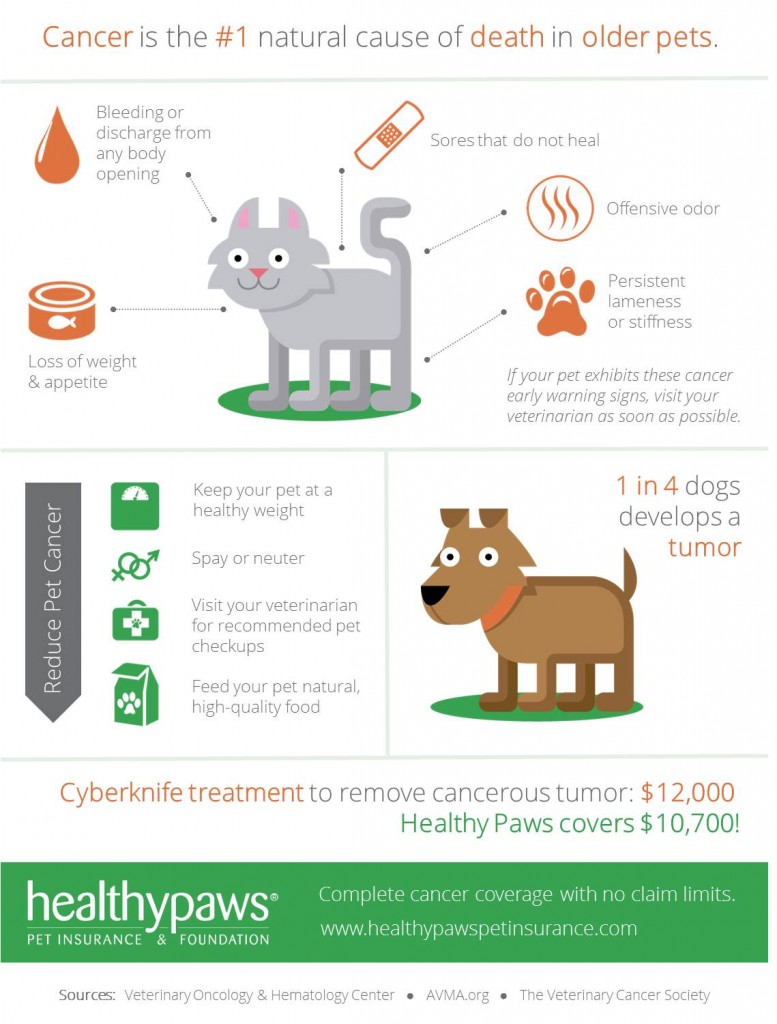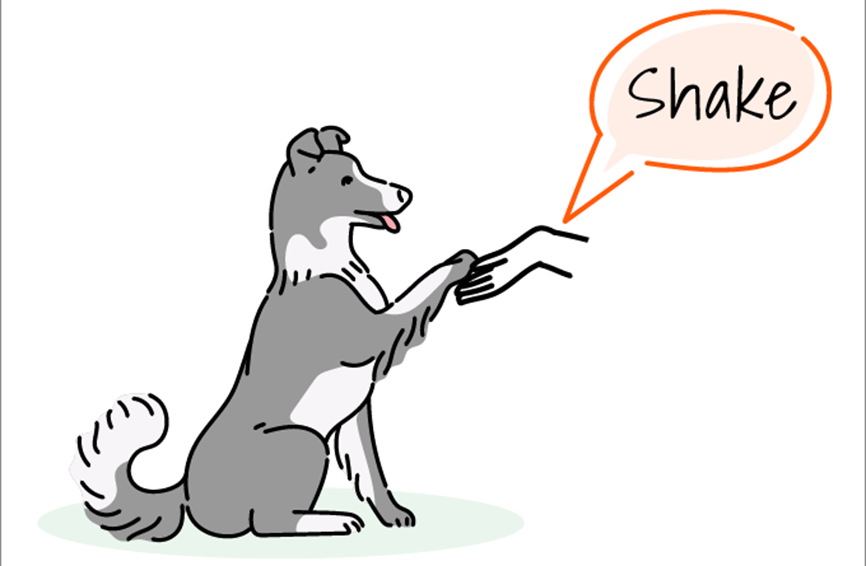Table of Contents
Updated Dec. 16, 2020
Key Takeaways
- Cancer is the number one cause of death in senior pets and comes in many forms.
- Pets who get cancers such as lymphoma, bone, or blood cancer can be treated with chemotherapy, surgery, or radiation treatment.
- Cancer is among the most expensive conditions to treat, which is why pet health insurance is a good idea.
Cancer affects millions of people each year—but humans aren’t the only creatures that can be diagnosed. Pets get cancer, too; in fact, cancer is the number one cause of death in senior pets; roughly one in four dogs will get cancer in their lifetime.
Unfortunately, life-saving cancer treatment for dogs and cats isn’t cheap. The average cancer treatment process for a beloved pet can cost $10,000 or more. This may include everything from tumor removal surgeries to blood work, X-rays, medication, and even special dietary needs.
There’s no getting around it: cancer can be awful for both you and your pet. Understanding what to expect can help you prepare for the possibility that your pet could be affected at some point in their life—and how you can budget for it.
Understand How Cancer Can Affect Your Pet
Like a human, your dog or cat can get several different types of cancer depending on their species, age, and other factors. A few examples of pet cancer are listed below.
Lymphoma
Dogs can get lymphoma, but cats with feline immunodeficiency virus (FIV) or feline leukemia virus (FLV) are especially susceptible to it. In cats, it generally attacks the kidneys or intestinal tract; in dogs, it is found in other parts of the body. Appetite changes, behavioral issues, and sudden or unexplained weight loss can signal the early stages of the disease.
Bone Sarcoma
Osteosarcoma, or bone sarcoma, affects dogs—especially larger breeds that take longer to grow mature, strong bones. It affects their bones and can make physical activity difficult, if not impossible. Cats can also get this type of cancer; it can degrade their back legs, and shoulders.
Hemangiosarcoma
This kind of cancer is found in middle-aged to older dogs. The root cancer stems from blood cells in different body tissue, leading to liver or spleen tumors. It’s relatively common, and surgery for it can be expensive.
Cancer diagnosis
According to the American Veterinary Medical Association, to diagnose cancer, your vet will want to run several tests in addition to a physical exam, depending on the type of cancer suspected. The techniques to provide a definitive diagnosis will be specific to the kind of cancer it is believed to be.
These may include:
- Radiographs (X-rays)
- Blood tests
- Ultrasound exams
- Cytology (withdrawing some cells from a mass to examine under a microscope)
- Biopsy (taking a tissue sample from the tumor or mass)
- Computed Tomography (CT) scan
- Magnetic Resonance Imaging (MRI)
- Positron Emission Tomography (PET) scan
- Rectal exam (for detecting anal sac tumors)
- Urinalysis (to detect Transitional Cell Carcinoma (TCC)
Cancer treatment for your pet
While cancer is a scary diagnosis for any pet parent, medical advances in animal health care means it’s more treatable than ever. Many pets are now living for years after their diagnosis and treatment. According to Pet Cure Oncology, the most common treatments for pet cancer are chemotherapy, radiation, and surgery.
Surgery
Surgery is often the first treatment recommended when the cancer is localized to one part of the body, with the goal being to eliminate the cancerous cells from the animal’s body. It may include complete or partial removal of a tumor or exploration of a particular area to obtain a sample of tumor tissue and evaluate how normal the tissue is, according to Oncolink. In situations where total removal is not possible, surgery may not be as effective as other treatments. It is often combined with radiation treatments.
A one-time surgery can cost $500 and up, especially if the tumor is located in a hard to reach location, according to the Cornell University College of Veterinary Medicine.
Chemotherapy
The cost of treatment can ranges widely, depending on the pet and where the cancer is located. A chemotherapy dose can range from $150 to $600, with a full treatment series reaching into the thousands, according to the Veterinary Cancer Society.
Radiation therapy
Instead of or in combination with chemotherapy or surgery, radiation therapy may be recommended as a more targeted treatment.
Conventional radiation therapy uses targeted radiation to shrink or destroy cancers that cannot be entirely removed by surgery alone. A more advanced form of radiation treatment is stereotactic radiation (SRT), also known as CyberKnife™ Radiosurgery, a non-surgical procedure that only requires one to three treatments. For most dogs and cats, the result is more significant damage to the tumor with less severe side effects over fewer radiation treatment sessions.
For conventional radiation, from 15-21 treatments will be needed over several weeks.
Immunotherapy
While not widely used for cancer, this is a biological therapy that involves antibodies to boost the body’s natural defenses by either stimulating the immune system to fight the cancer cells or by counteracting signals produced by cancer cells that suppress the immune system.
Cryotherapy
This treatment uses cold temperatures to kill cells. It is best suited for small, superficial tumors and is commonly used in areas such as the skin, eyelids, oral cavity, and peri-anal region, says Pet Cure Oncology.
Palliative Therapy
Sometimes pet parents may decide not to treat cancer aggressively, particularly if the cancer is too far advanced and remission is not realistic. In this case, palliative therapy or care can be used to increase a pet’s comfort and quality of life. Usually delivered in weekly low-dose radiation treatments over three to six weeks, the goal is to relieve symptoms such as pain, bleeding, and decreased mobility as the pet lives out his life, according to Pet Cure Oncology.
Alternative therapies
Just as people turn to more natural solutions to treat cancer and other conditions, so are these treatments available to pets. Here are some common alternative therapies, according to Canine Cancer.com
Nutritional therapy
Proper nutrition is the best preventative medicine against cancer. A grain-free, high protein, high-fat diet – especially those that are frozen raw, dehydrated, or freeze-dried — is the best for fighting cancer, according to K9 medicinals. There is a wide variety in food quality, and individual dogs and cats have unique nutritional needs depending on heredity, health status, and lifestyle. Consult your vet for the best recommendations.
Acupuncture
Acupuncture treatments are generally given to support conventional and other alternative cancer treatments, says the Integrative Veterinary Center. Acupuncture can control pain and reduce chemo and radiation’s side effects, such as anorexia, vomiting, and diarrhea. Acupuncture is often combined with herbal medicine to rebuild the body from the damage done by chemotherapy and radiation, to prevent metastasis, and improve the overall quality of life.
Bone marrow transplants
While still fairly rare, these transplants are starting to be performed on dogs suffering from autoimmune diseases or cancers, such as lymphoma. The therapy uses a dog’s own stem cells to stimulate bone marrow function and immune system recovery following radiation to kill cancer cells. If successful, the treatment will result in a rising white blood count. Dogs with significant disease, those who relapsed after chemotherapy, and those with other serious illnesses are not considered good candidates for this treatment.
As you might expect, bone marrow transplants are expensive, starting at about $13,000 for initial treatment, post-transplant hospitalization for up to two weeks, and post-transfusion radiation therapy.
If your pet is receiving treatment and starts feeling ill, has diminished quality of life, or isn’t receptive to a drug, your vet may try another one, add other prescriptions to help manage the symptoms, or change the dosage and frequency.
How much will treating your pet’s cancer cost?
Cancer is expensive to treat. On average, a cancer treatment regimen can cost $10,000 and up. These costs are often spread out over a period of eight weeks from initial diagnosis, mass removal or chemotherapy, to follow up blood work, x-rays, and medication.
Pets who get the above types of cancer or another kind not listed could be facing chemotherapy, surgery, or radiation treatment. Even so, when a pet gets cancer, treatment options are typically designed to extend life or ease symptoms such as pain or reduced mobility. In most cases, treatment will not remove cancer or put it into remission. Vets may also prescribe pain medications to help with pain caused by cancer.
Coping with the cost of treatment
Veterinary oncology continues to make strides in treatment options and effectiveness, but those costs can seem insurmountable for some owners. Pet owners can protect their wallets in the case of their beloved furry friend’s cancer diagnosis with pet insurance.
Pet parents with a Healthy Paws insurance plan can see as much as 90 percent of the cancer treatment cost covered by their policy. Also, having coverage offers some financial peace of mind if there’s a relapse and more charges are incurred.
A nasal tumor, normally treated with 15-20 radiation sessions costing up to $10,000, can be treated with CyberKnife™ Radiosurgery, targeting the tumor in just three sessions. For a dog named Baxter, that meant a better chance at life—and for his pet parents. They had a pet insurance policy through Healthy Paws Pet Insurance that covered over $18,000 of the original $21,000 price tag. Not only is Baxter now enjoying a healthy life, but his pet parents were able to afford to give him that second chance with insurance.
Dug’s cancer treatment story
 “Dug is one of the happiest, most relaxed pups you’ll ever meet. He is always smiling, somewhat mischievous, super playful, and yet a little bit of an old soul,” says Dug’s pet parent Lisa. “When he started acting extremely lethargic, and the lymph nodes underneath his jaw swelled up to the size of golf balls in over a period of two days or so, we knew immediately something was wrong and took him to the emergency vet.” At six years old, Dug was diagnosed with lymphoma. His pet parents, Lisa and Arvin, decided they would help Dug fight the disease with every resource they could, including chemotherapy administered by a veterinary oncologist.
“Dug is one of the happiest, most relaxed pups you’ll ever meet. He is always smiling, somewhat mischievous, super playful, and yet a little bit of an old soul,” says Dug’s pet parent Lisa. “When he started acting extremely lethargic, and the lymph nodes underneath his jaw swelled up to the size of golf balls in over a period of two days or so, we knew immediately something was wrong and took him to the emergency vet.” At six years old, Dug was diagnosed with lymphoma. His pet parents, Lisa and Arvin, decided they would help Dug fight the disease with every resource they could, including chemotherapy administered by a veterinary oncologist.
Dug had three rounds of chemo and suffered minimal side effects. “The first 48 hours after chemo, Dug was typically lethargic and had diarrhea,” says Lisa. “Other than that, he really is a champ and the symptoms often subside. Once in a while, his stomach will bother him, and we will then give him Cerenia to help him eat.”
“The doctor says he’s a miracle pup that he’s still alive. We’re blessed on all sides and so happy to have Healthy Paws behind us,” Alvin said. From the diagnosis and first round of chemo, Arvin and Lisa were reimbursed $12,450 and then another $12,590 for ongoing care and two more rounds of chemo. That’s a total of $25,040 that Healthy Paws covered.
The emotional side effects
Dealing with a pet suffering from a chronic or serious acute illness is incredibly heart-wrenching for pet parents, and support groups sprinkle the internet with friendly faces going through the same thing.
“For us, our experience has been a roller coaster ride,” explains Lisa. “Dug is on his third protocol which means the lymphoma is present for a third time and every time it reappears, it breaks our hearts and reminds us that the inevitable is coming. While we are extremely grateful for his reaction to the chemotherapy and extension of life, nothing really prepares you for the loss of your pet or in our case, our child.”
 They focus on Dug’s favorite activities – cuddling, chewing up tennis balls, and chowing down on organic duck treats – to keep his quality of life maintained as they fight cancer together. “On a positive note, we have worked with the best oncologists that genuinely care for Dug and this is all because we had the resources to do so with pet insurance,” continues Lisa. “The vets have made it possible to have [Dug] with us for an additional 17 months now!”
They focus on Dug’s favorite activities – cuddling, chewing up tennis balls, and chowing down on organic duck treats – to keep his quality of life maintained as they fight cancer together. “On a positive note, we have worked with the best oncologists that genuinely care for Dug and this is all because we had the resources to do so with pet insurance,” continues Lisa. “The vets have made it possible to have [Dug] with us for an additional 17 months now!”
By having pet insurance, Lisa and Arvin were able to focus on Dug’s health, rather than stressing over the bills or wondering if they can afford the next steps. Many pet parents have found that removing the financial stress has helped them cope emotionally with their pet’s illness. Others reach out to friends or acquaintances on social media going through the same ordeal. Some popular Facebook groups include Canine Cancer Facebook Group, an offshoot of CanineCancer.com, the more general Pet Cancer Support Facebook Group, and a Lymphoma-Chemo specific group, LymphomaHeartDogs in Chemo.
Bottom line
Pet cancer can be a heartbreaking reality for many pet parents. It can be emotionally devastating to deal with the disease and treatment. Furthermore, when you want to do everything possible, it can be challenging on many levels if your wallet won’t let you.
This is why it may be helpful to consider pet insurance. In some cases, pet health insurance can help mitigate those high costs and offer financial peace of mind. With the right insurance policy, you could be ready for just about anything—including a dreaded cancer diagnosis in your pet. If you think you could end up paying large vet bills, look into pet insurance. It could be the deciding factor in how much time you get to spend with your pet.
The content is not intended to be a substitute for professional veterinarian advice, diagnosis, or treatment. Always seek the advice of your veterinarian or other qualified health provider with any questions you may have regarding a medical diagnosis, condition, or treatment options.









